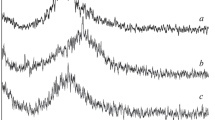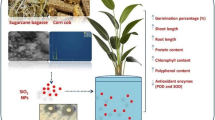Abstract
Plant-based biogenic silicon dioxide nanoparticles are used to produce catalysts, additives, templates for deposition of other semiconductors and metals, nanomaterials with novel properties, bio-nanocomposites for biomedical, energy and environmental fields. There are too many ways of bio-SiO2 production. Dependent on the way and obtaining condition some properties of the plant-based biogenic silicon dioxide nanoparticles can be changed. The most amount of silicon is accumulated in stalks and husk biomass of rice, buckwheat and oats. The aim of our work was the investigation of physic-chemical properties of the biogenic silicon dioxide obtained from the rice husk by both ecologically- and economically-friendly technology. The fluoric technology was used for silicon dioxide isolation. Our technology allows us to restore used catalysts. Thus this technology is ecologically and economically efficient. The synthesised SiO2 was studied by using the following methods: low-temperature nitrogen sorption–desorption, XRD, XRF, ICP-MS, AFM, FTIR-ATR, SEM-EDS, TGA. It was established that obtained samples had a specific surface area 107 m2/g. The XRD of the powdered SiO2 showed 100% amorphous characteristics of the material. FTIR, XRF SEM-EDS, ICP-MS and X-ray diffraction indicated that samples contain only SiO2. AFM results show obtained silica particles were having shape from spherical to lamellar. According to SEM investigated sample consists of spherical small aggregates.
Similar content being viewed by others
Explore related subjects
Discover the latest articles, news and stories from top researchers in related subjects.Avoid common mistakes on your manuscript.
Introduction
The list of products that can be obtained from agricultural wastes is determined by their chemical composition (Isikgor and Remzi Becer 2015; Shen 2017). Rice wastes (straw, husk) is known to contain, in addition to oxides of calcium, aluminium, magnesium, sodium, potassium, silicon dioxide in an amorphous state, and its content is the highest among other crops (Ikawo 2013; Mistry 2016; Rungrodnimitchai et al 2009; Zemnukhova et al 2009; James and Rao 1986).
One tonne of rice yields about 200 kg of the husk, which gives almost 40 kg of ash with 85–98% silica content. Despite the fact that the mass fraction of rice wastes is not constant and depends on the place of rice cultivation, the conditions of its collection and processing, the high content of silicon dioxide in the ash residue make such raw materials promising for its production. Rice husk is difficult to dispose. It is characterised by high ash content, low nutritional value, and it is limited in using as recyclable material. However, it is a source of biogenic silica, which is characterised by the highest physiological activity compared to inorganic silicates (Van Dyck et al. 1999). Besides, this form of silicon dioxide has the highest reactivity, which together determines its significant value.
Silicon dioxide plays an important role as ingredients in food, pesticides and personal care products; as fillers in plastics, rubber and coatings, and as a raw material for semiconductors, silicates and ceramics (Oertel 2013; Davraz and Gunduz 2005; Musić et al. 2011; Kumar et al. 2012; Liu et al. 2013). Recent studies on the use of silicon in biomedicine were carried out (Salazar-Hernández Carmen et al. 2017; Suriyaprabha and Rajendran 2017; Lad and Agrawal 2014). Amorphous silicon oxide with a high specific surface area is essential for many key chemical fields, including absorbents, thermal insulation materials, catalysts and their carriers (Sari et al. 2015). High-purity amorphous silica is produced by a multi-stage process, which is associated with high temperatures, pressures, is energy-intensive and environmentally hazardous. To avoid the above-mentioned obstacles in the production of silica and to be able to meet the high and further growing demand for silicon dioxide, it is necessary to look for an economical, environmentally friendly approach to the production of high-purity silica.
Most often, the rice husk is used to produce silicon dioxide by the following methods: enzymatic processing of raw materials and their combustion (Ikawo 2013; Chen 2013); oxidative combustion of raw material at a temperature of about 800 °C (Pat GB 1975; Chen 2013); obtaining intermediate by the second method followed by leaching of inorganic impurities with acids (Gridneva et al 2010; Tsoi 2015; Chen 2013); leaching of raw material with acid and burning of insoluble residue; hydrolysis of raw materials with alkali followed by precipitation of silica with acid (Tsoi 2015; Chen 2013). The unifying drawback of the work in this direction is the difficulty of obtaining high-quality silicon dioxide due to the presence of impurities, especially potassium and sodium, in the feedstock and problems of burning off carbon out from ash residue. A deterrent in the processing of rice husk is the need to comply with certain boundary conditions when the sample is still in an amorphous state. As an example, it can be noted that the long process of heat treatment contributes to the orderliness of the structure of silicon dioxide, and at the temperature of 1000–1100 °C biogenic amorphous silica goes into a crystalline state. Most of the proposed approaches are low-productive, environmentally-unfriendly, not energy-efficient and unprofitable. Therefore, the search for modern highly efficient ways of obtaining biogenic silicon dioxide from plant wastes is an urgent task.
The aim of our work was the investigation of physico-chemical properties of the biogenic silicon dioxide obtained from the rice husk by both ecologically- and economically-friendly technology.
Materials and methods
Air-dry rice husk (fraction 2–5 mm) from Kherson's region of Ukraine with the following characteristics: humidity 10%, the proportion of inorganic components to dry weight of 18% (Table 1) and the proportion of organic components—82% (H—6.63, C—38.27, S—0.17–0.52, N—2.81–3.00, O—51.58–52.12% mass) was used.
Extraction of silica
The pre-ground air-dry rice husk was placed in a steel reactor and subjected to rapid heating in an induction field at 900–1100 °C with the heating of 0.03–0.05°/s using earlier described equipment (Kashkovsky et al. 2017). The process of thermal decomposition was carried out until complete visible cessation of gas evolution (3–4 min). The composition of the obtained gas was H2—36.5, CH4—6.4, CO—31.8, hydrocarbons C2–C7—1.0, N2—2.6, CO2—21.7% mass. By complete firing, it was found that the residue consists of the carbon component (54–56%) and the inorganic component (44–46%). The last one contains 95–98% of silicon dioxide.
To the obtained carbon-containing, ash residue (the particles of silicon dioxide and carbon are approximately the same) was added ammonium fluoride in a ratio of 1:5. The resulted mixture was carefully ground, and then it was loaded into a graphite reactor and heat-treated at 150–200 °C. The reactor was connected to a gas capture system formed during the fluorination process. The gas trapping system is designed in such a way that water, ammonia, and ammonium vapour can be condensed simultaneously to form a suitable mixture of solutions and prevent gas from escaping into the environment. The end of the ash fluorination process is determined by the cessation of gas evolution. The fluorated carbon-containing ash residue was heat-treated at 290–500 °C. The resulted white ammonium hexafluorosilicate powder was dissolved in distilled water and 15–35% ammonia solution was added to the solution with simultaneous pH control (final pH value 10.0–12.0 pH units). The formed insoluble hydrogel was washed 4–8 times by distilled water to remove fluoride residues, the filtered product was dried at 100–120 °C to constant weight and annealed at 550–750 °C to give a white powder. The resulted ammonium fluoride is returned into the beginning of the process according to our technology (Pat. UA 2018).
Characterisation of silica
Chemical analysis was conducted to determine the purity of the silica using Expert 3L XRF analyser and inductively coupled plasma-mass spectrometry (ICP-MS). The porous properties of the prepared silica were studied using N2 adsorption at − 195.8 °C on the specific surface area and porosity analyser Nova 1200e (Quantachrome, USA). The scanning electron microscopy (SEM) images were taken using Zeiss Evo-10 (Carl Zeiss Microscopy, USA) microscope working at 20.0 kV with energy dispersion spectroscopy (EDS, attached to the SEM). The phase identification of the products was examined under X-ray diffraction (XRD) using the MiniFlex 300/600 diffractometer (Rigaku, Japan). The diffraction patterns were recorded using Cu–Kα radiation (λ = 1.5418 Å), the operating voltage of 40 kV and current of 15 mA. XRD pattern of samples was obtained in the 2θ range between 10° and 85° with a step of 0.02°. FTIR analysis of the obtained silica was performed using IRAffinity-1S FTIR spectrometer (Shimadzu, Japan) equipped with a Quest ATR Diamond GS-10800X (Specac, UK) within the wavenumber range of 4000 to 400 cm−1. The surface morphology was investigated with an atomic force microscope (AFM) NT-206 (Company with double liability “Microtestmachines”, Belarus) equipped with standard sonde CSC37 and rigidity of console 0.3–0.6 N/m. The scan was run in a contact static mode at 10 mcm/s with a step of 0.3 nm. The SiO2 sample suspension (0.5% in 96% ethyl alcohol) was treated in an ultrasonic bath of MCU Intelligent Ultrasonic Cleaner (China) at 50 W for 50 min. Two drops of the obtained sample were applied on quartz glass or mica and dried for 1 h at 50 °C. Then the scan was performed on AFM. Thermogravimetric analysis (TGA) was performed with a PT1600 TG–DTA/DSC (STA Simultaneous Thermal Analysis, LINSEIS Messgeräte GmbH, Germany). The samples (13.8 ± 0.1 mg) were collected in a standard corundum pan. The scan was run at 5 °C/min under a flow of air. The mass change was measured from 15.8 to 1000 °C. The sample was analysed three times.
Results and discussion
Table 2 shows the textural properties observed in the obtained silica. Nitrogen adsorption (Brunauer–Emmet–Teller, BET) measurements (Table 2) indicate that specific surface area of the silica particles is according to USA, Europe and China standard for amorphous silica (CCAA 2018).
Major contaminants of the trace elements in studied silica were determined via XRF (SiO2—100% mass) and ICP/MS (Table 3). The amorphous silica content was 99.9995% with only trace quantities of other mineral oxides.
XRD pattern of the obtained silica showed that the 2-theta region between 5° and 45° at long collection times indicates no crystalline peaks (Fig. 1). Crystallinity above 0.01% by weight would be visible as sharp peaks on the diffraction pattern. The X-ray diffractogram of the powdered silicon shows characteristic features of amorphous materials (Fig. 1). An amorphous broad peak with the equivalent Bragg angle at 2θ = 21.8° was recorded (Suriyaprabha and Rajendran 2017).
The FT-IR spectrum of the silica (Fig. 2) shows typical functional groups correspond to pure silicon dioxide at 1074, 982, 800 and 457 cm−1. The very strong and broad IR band at 1074 cm−1 with a shoulder at 1180 cm−1 is usually assigned to the transversal optical (TO) and longitudinal optical (LO) modes of the Si–O–Si asymmetric stretching vibrations. The short peak at 982 cm−1 can correspond to Si–O-stretching vibrations. The observed sharp peak at 800 cm−1 can be assigned to Si–O–Si symmetric stretching vibrations, whereas the IR band at 457 cm−1 is due to Si–O–Si bending vibrations (Tran et al. 2013; Salazar-Hernández Carmen et al. 2017).
Figure 3a shows the topography of the surface with the line of cross-section 1–2, as well as a three-dimensional image of the surface (Fig. 3b). As a result of the evaporation of the solvent, a set of nanoparticles, which are shaped from spherical to lamellar, is formed on the surface. The surface roughness makes 2.1 nm. Analysis of section profile 1–2 (Fig. 3c) indicates that ∅ of the particles is 49.8; 8.2; 11.4; 27.3; 51.0 nm. When the scan is reduced to 8 × 8 microns, oblong particles can be distinguished in the image (Fig. 3d, e). In Fig. 3d, e the line of cross-section 1–2 of the selected particles in different directions are given. The data of the line of cross-section 1–2 indicate that the width of such a nanoplate is 404.7 nm, the length is 717.1 nm, and the height in the cross-section is from 24.4 to 29.3 nm.
The scanning electron micrograph (Fig. 4) illustrates the small aggregates, which are peculiarities for silicon dioxide (Ya et al. 2014). It’s observed that, silica samples have a spherical morphology and regular shape (Ruchi Nandanwar et al. 2015). The EDS analysis confirms the purity of the obtained silica (Table 4).
Thermogravimetric analysis (TGA) of obtained bio-SiO2 (Fig. 5) shows only a typical mass lost below 100 °C, which corresponds to water loss (Lin and Zhou 2017).
Conclusion
Using an original combination of various technical solutions, biogenic high-purity silicon dioxide was obtained from the rice production waste. The resulting material was studied by modern physicochemical methods, confirming its amorphous structure, high content of the main product (silicon dioxide), which showed the presence of the silica in the form of nanoparticles of various morphologies. Due to the high demand for biogenic silicon dioxide for the production of sorbents to medicine and chromatography, catalysts and their carriers; in the electronic industry; for the manufacture of other silicon compounds (carbide, nitride, chloride, organosilicon, pure silicon), luminophore, abrasives, sound- and thermal-insulation materials, etc. Our environmentally friendly technology is an ideal solution for obtaining high-purity silica.
References
Carmen S-H, Mercedes S-H, Rocío L-R, Enrique E-R, Hilario R-RA (2017) Silica from rice as new drug delivery systems, rice—technology and production. Amanullah and Shah Fahad, IntechOpen. https://dx.doi.org/10.5772/66723. https://www.intechopen.com/books/rice-technology-and-production/silica-from-rice-as-new-drug-delivery-systems. Accessed 21 Nov 2019
CCAA (2018) Amorphous silica properties, characterisation and uses. https://www.ccaa.com.au/imis_prod/documents/TECH_NOTE_79_-_Amorphous_Silica.pdf. Accessed 21 Nov 2019
Chen H (2013) Biogenic silica nanoparticles derived from rice husk biomass and their applications. Dissertation, Texas State University
Davraz M, Gunduz L (2005) Engineering properties of amorphous silica as a new natural pozzolan for use in concrete. Cem Concr Res 35:1251–1261. https://doi.org/10.1016/j.cemconres.2004.11.016
Gridneva TV, Soroka PI, Tertyshnyj OA, Ryabik PV, Smirnova ES (2010) Poluchenie dioksida kremniya iz risovoy sheluhi. Ekologichni aspekty ta resursozberigayuchi technologii 3:100–102
Ikawo OE (2013) Conversion of agrowastes to bioproducts. University of Lagos. https://www.academia.edu/3270728/CONVERSION_OF_AGROWASTES_TO_BIOPRODUCTS. Accessed 22 Nov 2019
Isikgor FH, Remzi Becer C (2015) Lignocellulosic biomass: a sustainable platform for the production of bio-based chemicals and polymers. Polym Chem 6:4497–4559. https://doi.org/10.1039/C5PY00263J
Jose James M, Rao S (1986) Silica from rice husk through thermal decomposition. Thermochim Acta 97:329–336. https://doi.org/10.1016/0040-6031(86)87035-6
Kashkovsky VI, Yevdokymenko VA, Kamensky DS, Tkachenko TV, Vakhrin VV (2017) Complex technology for processing some organomineral waste. Sci Innov 13(3):51–61. https://doi.org/10.15407/scine13.03.051
Kumar DA, Shyla JM, Xavier FP (2012) Synthesis and characterization of TiO2/SiO2 nano composites for solar cell applications. Appl Nanosci 2:429–436. https://doi.org/10.1007/s13204-012-0060-5
Lad AN, Agrawal YK (2014) SiO2-based nanobiosensor monitoring toxicological behavior of Mitoxantrone in vitro. Appl Nanosci 4(5):523–529. https://doi.org/10.1007/s13204-013-0239-4
Lin B, Zhou S (2017) Poly(ethylene glycol)-grafted silica nanoparticles for highly hydrophilic acrylic-based polyurethane coatings. Prog Org Coat 106:145–154. https://doi.org/10.1016/j.porgcoat.2017.02.008
Liu N, Huo K, McDowell MT, Zhao J, Cui Y (2013) Rice husks as a sustainable source of nanostructured silicon for high performance Li-ion battery anodes. Sci Rep 3:1919–1925. https://doi.org/10.1038/srep01919
Mistry B (2016) Properties and industrial applications of rice husk. IJESC 6(10):2677–2679
Musić S, Filipović-Vinceković N, Sekovanić L (2011) Precipitation of amorphous SiO2 particles and their properties. Braz J Chem Eng 28(1):89–94. https://doi.org/10.1590/S0104-66322011000100011
Nandanwar R, Singh P, Haque FZ (2015) Synthesis and characterization of SiO2 nanoparticles by sol–gel process and its degradation of methylene blue. ACSj 5(1):1–10. https://doi.org/10.9734/ACSj/2014/10875
Oertel T (2013) The influence of amorphous, sub-micrometer silica particles in cement pastes and mortars with very low water-to-cement ratios (ultra-high performance concrete). Dissertation, Universitat Bayreuth
Pat GB 1508825 (1975) Refratech Albert Gmbh. A method of production low-carbon, white husk ash 26.03.1975
Pat UA 117881 (2018) Yevdokymenko VA, Kamenskyh DS, Kashkovsky VI, Vakhrin VV Method of producing amorphous silicon dioxide from the rice husk. 10.10.2018
Rungrodnimitchai S, Phokhanusai W, Sungkhaho N (2009) Preparation of silica gel from rice husk ash using microwave heating. JMMM 19(2):45–50
Sari ZGLV, Younesi H, Kazemian H (2015) Synthesis of nanosized ZSM-5 zeolite using extracted silica from rice husk without adding any alumina source. Appl Nanosci 5(6):737–745. https://doi.org/10.1007/s13204-014-0370-x
Shen Y (2017) Rice husk silica derived nanomaterials for sustainable applications. Renew Sustain Energy Rev 80:453–466. https://doi.org/10.1016/j.rser.2017.05.115
Suriyaprabha R, Rajendran V (2017) A lucrative chemical processing of bamboo leaf biomass to synthesize biocompatible amorphous silica nanoparticles of biomedical importance. Appl Nanosci 7:145–153. https://doi.org/10.1007/s13204-017-0557-z
Tran TN, Van Anh T, Pham ML, Le P, Nguyen TPT, Tran VM (2013) Synthesis of amorphous silica and sulfonic acid functionalized silica used as reinforced phase for polymer electrolyte membrane. Adv Nat Sci Nanosci Nanotechnol 4:1–6
Tsoi EA (2015) Silicon containing material from rice straw: compound, structure and properties. Dissertation, Far Eastern Federal University
Van Dyck K, Van Cauwenbergh R, Robberecht H, Delstra H (1999) Bioavailability of silicon from food and food supplements. Fresenius J Anal Chem 363:541–544. https://doi.org/10.1007/s002160051243
YaA K, Gaishun VE, Tyulenkova OI, Denisman VG, Gerasimenya TA, Matyushonok OA (2014) AFM and SEM study on the morphology of SiO2 nanoparticles in polishing slurries. Chem Phys Technol Surf (Himia, Fizika ta Tehnologia Poverhni) 5:89–93
Zemnukhova LA, Budaeva VV, Fedorishcheva GA, Kaydalova TI, Kurilenko LN, Shkorina ED, Ilysov SG (2009) Inorganic components of straw and hull of an oats. Himija rastitel'nogo syr'ja (Chem Plant Raw Mater) 1:147–152
Acknowledgements
The experiments and laboratory installation assembling have been funding by Target Complex Program of Scientific Research of the National Academy of Science of Ukraine from the development of scientific principles of rational use of natural resource potential and sustainable development, project 14, 2015–2019.
Author information
Authors and Affiliations
Corresponding author
Ethics declarations
Conflict of interest
On behalf of all authors, the corresponding author states that there is no conflict of interest.
Additional information
Publisher's Note
Springer Nature remains neutral with regard to jurisdictional claims in published maps and institutional affiliations.
Rights and permissions
About this article
Cite this article
Tkachenko, T., Yevdokymenko, V., Kamenskyh, D. et al. Physico-chemical properties of biogenic SiO2 nanoparticles obtained from agriculture residue. Appl Nanosci 10, 4617–4623 (2020). https://doi.org/10.1007/s13204-020-01383-1
Received:
Accepted:
Published:
Issue Date:
DOI: https://doi.org/10.1007/s13204-020-01383-1










